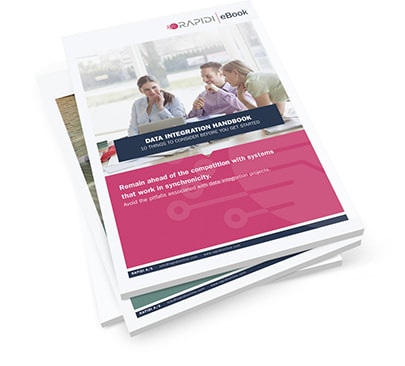Today, Salesforce-ERP integration is very possible. There are several ways to approach Salesforce ERP integration with your current Enterprise Resource Planning (ERP) solution. The real question is which Salesforce-ERP option you should integrate with and which solution will best suit your needs and business processes.
Where to Start with Salesforce-ERP Integration
Salesforce has become one of the most popular Customer Relationship Management (CRM) systems. Many companies wish to integrate Salesforce with their current ERP system. Companies want updated customer data in both their CRM and ERP systems and generally to improve their business processes through better productivity, efficiency, data value, and security.
To start, you should consider top-level questions for ERP integrations like whether you want a custom integration build, prefer a data integration platform, or would like a flexible software-based integration process for your data systems, accuracy, and ease. Many standard integration processes may fit your needs, as you'll see in this post, but some will require more time, money, and energy than other systems.
If you have an existing integration process and want to customize your Salesforce-ERP integration, you should consider which solution affords you the greatest flexibility with the least amount of technical skills required.
Here's a quick guide that will help you evaluate your data integration options and make the best decisions to fit seamlessly with your ERP system.
Choosing the Right Solution for Salesforce-ERP Integration
Build your own Salesforce-ERP integration
Building a custom integration can be a tempting alternative to the ready-to-use ERP software integration platforms. Be aware that custom-made interfaces tend to have a higher initial cost compared to ready-to-use data integration platforms for ERP integration. You must build the integration from scratch, which means you'll invest a lot more time, money, and talent on your enterprise resource planning tool to ensure a solid ERP integration.
Ready-to-use Salesforce-ERP integration solutions may have a lower long-term maintenance cost; but, the actual maintenance costs cannot be precisely defined at an early stage as you cannot have an overview of the changes you will need to perform in the future. On the other hand, custom Salesforce integration transfers with ERP systems rarely include additional functionality within scheduling, error handling, monitoring, etc.
A better option is to choose a cloud-based ERP system and CRM software integration solution that relies on templates to improve business processes by integrating data without technical and time demands. Consider the following options for ERP integration with platforms and templates. Then, see which one will give your ERP system the integrated boost it needs to streamline enterprise resource planning and operations with synchronized customer data.
ERP Integration Platforms
If you decide to invest in an established integration platform, you will benefit from years of best practices integrating Salesforce with ERP. Today, a ready-to-use Salesforce integration platform is fast, user-friendly, and robust. It is generally difficult to say how much a Salesforce-ERP integration should cost when you rely on a custom, technical build in-house because the process could take months of development before an ERP solution emerges to merge data from Salesforce and other systems. As a result, data integration platforms can be an affordable alternative.
Pre-configured Integration Templates
Most companies have common ways of working and therefore have similar requirements. To meet these types of requirements, Salesforce integration tools can include a number of pre-configured integration points.
For example, the Rapidi integration for Salesforce comes out of the box with pre-configured end points for Microsoft Dynamics AX, NAV and GP, 365 Business Central and 365 for Finance & Operations. Having a properly configured ready-to-use end point for these systems could be the fastest and easiest way to perform Salesforce-ERP integration.
Access to these pre-configured templates makes data mapping smooth and easy, facilitates scheduling and sequencing of your data transfers, and lets you handle errors in the most efficient way. They can also be developed to follow the updates and upgrades of your integrated systems, which is a huge advantage moving forward for ERP insight, operations, and value.
Data integration platforms have evolved considerably in the past few years. Solutions like Rapidi have been developed to make Salesforce-ERP integration robust, fast, simple and affordable. It might just be the most reasonable approach to systems integration on the market.
Deciding on Transfer Data within Salesforce-ERP Integrations
There are many possible integrations between CRM and ERP platforms, especially for service and case management (Service Cloud), and more than appear in the table above. However, they all follow a similar logic within ERP software and customer data to allow information to pass from point to point within ERP system integration.
ERP integration does not have to be complex. Simple ERP integration platforms such as Rapidi can be an affordable, simple, and solid as an alternative to custom integrations. Unlike custom ERP solutions to establish an integration process, Rapidi offers ready-to-use integrations with standard templates for most ERP systems and software. Even setting up a custom integration only takes a couple of days (depending on scope) without the need for IT skills to connect customer data and enterprise resource planning.
Use Rapidi for an Improved, Integrated ERP
Instead of using manual data entry or custom integrations developed in-house, you can use Rapidi, a top-rated software solution for CRM and ERP integration. As you aim to increase customer satisfaction through better customer data and improve business processes with better ERP insights, Rapidi can help by offering easy-to-use templates for mapping onto your system in a matter of hours or days, rather than weeks or months.
By being able to take your information, customers, and sales out of data silos, you can boost business functions and processes without changing your data accuracy or consistency. Even if you use legacy systems for your ERP solution, you can find easy integration processes are possible when you use pre-configured templates from a top-rated cloud-based solution for ERP integration.
Check out the options for integration available from Rapidi, and see how project management, customer relations, and enterprise resource planning can be transformed.









